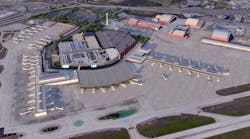The COVID-19 pandemic resulted in an unprecedented global collapse for the travel industry, compounded by the sharp downturn in the air transport sector and its supply chain. Many industry stakeholders predicted that 2022 would be the year in which aviation figures would begin to spike to levels seen pre-pandemic. In keeping with this theory, global leisure and business flights have risen to levels not seen since 2019 according to the Mastercard Economics Institute’s analysis of 37 global markets.
As travel figures begin to take shape in the more familiar form of pre-pandemic life, it begs the question of whether the travel sector can afford to simply revert to pre-pandemic operations in the absence of COVID protocols and safety measures. A firm "reset" to 2019 and for business as usual. But, as one delves further into the deep-seated requirement for the modernization of the aviation experience for customers, the answers become increasingly apparent that the pandemic was merely an accelerator, not a curator of the need to build a more resilient, safe, efficient, and user-friendly airport and travel experience.
So, if the need to upgrade operations and infrastructure was a pre-existing issue prior to the pandemic, has the outbreak of COVID-19 changed anything other than the pace at which we need to implement these changes? In fact, yes. The pandemic has taught the industry many things, not least the benefit of biometric technology when it comes to rapidly and securely processing passengers in an environment whereby contactless interaction with physical touchpoints became essential. Biometric technology provides the sector with the tools needed to not only improve the user experience in the current day but to be more resilient to future challenges, for years to come.
The technology required to modernize traveler experiences and support safety is already designed and available. Safe, seamless, and contactless travel demands an all-encompassing ecosystem where travel stakeholders collaborate across the whole journey experience. The Vision-Box Orchestra Identity & Border Management Platform had been designed to enable just that. As a collaborative platform of real-time intelligence, it is designed to accommodate large volumes of information on passenger identity, passenger flows, connected devices, and third-party systems, thus streamlining communication between all travel stakeholders and crucially, putting the passenger’s interests at the core.
Advances in biometric identification technologies hold the key to delivering seamless experiences where travelers can simply walk through a series of touchpoints without the need to physically interact with human operators. The pandemic provides a pertinent example of why "no-touch technologies" are so important for the future of travel and reinforces the case for retrofitting outdated hardware and implementing cutting-edge software to streamline the flow of travelers across air, land, and sea. The way passengers interact with travel stakeholders along their journey is transforming with passengers increasingly demanding easy-to-use, safe, and seamless experiences which put data privacy at the center. It’s sustained by the selection of a proven and scalable identity management platform, safeguarding all privacy and data protection measures to enable the sharing of data and travelers’ journey processes. Biometric technology will be the catalyst, not the enabler for this.
By implementing responsible data sharing between stakeholders in the airport ecosystem, the passenger’s facial recognition token becomes a secured key to access and consume information for personalization at retail outlets, restaurants, concession stands, and other way stations that enhance the passenger experience and help generate non-aeronautical revenue. This is only possible under privacy-first settlements and strict passenger consent processes, unleashing the power of data monetization and actionable intelligence.
Global Examples – Ahead of the Curve
The implementation of seamless and contactless platforms is currently at full speed all over the globe, and the major impact of this is expected to be felt by 2023, as planning and deployment usually needs 12 to 18 months to be effective. Airlines, such as Emirates and AirAsia, or airports, such as Felipe Angeles International Airport, in Mexico, Kuala Lumpur International in Malaysia or Bangalore Airport in India have been ahead of the market in investing in seamless biometric technologies. These airlines and airports are proof that we can digitize and automate time-consuming tasks and enable a frictionless experience for passengers, sustained by well iterated scale-up programs. All these initiatives and their respective business cases benefit from our facial recognition technology, which is specially developed and trained to deliver a truly seamless approach.
The implementation of biometric technology is the future of the travel sector is not news to most of the sector, but the consumer demand for this infrastructure has made it less of a debate and more of an industry demand as more and more travelers make their destination and airline decisions based on those which can provide the most seamless, safe and hassle-free experience.
Most importantly, the seamless and automated biometric technologies offer unparalleled levels of security and user privacy, which traditional analogue forms of processing cannot. Unlike physical checkpoints which rely on human judgement and safekeeping, automated biometric technology processes the existing data and information such as passenger biometrics on a secure network without the possibility for leaks or unauthorized access. In fact, Vision-Box has been ahead of the industry in subscribing to the highest privacy standards, with its Orchestra Digital Identity Management Platform achieving a renewal of its Privacy by Design certification, after an assessment by MSECB – the certification body specialized in the certification of management systems. The internationally recognized standard was once again granted to Vision-Box following a detailed assessment report submitted as result of KPMG audit. Privacy by Design is a framework based on proactively embedding privacy into the design and operation of IT systems, networked infrastructure, and business practices.
We believe that the future is biometric, and at the same time commit to the highest standards of user privacy. The future cannot just be seamless, it needs to be secure as well.
“Pedro Pinto is a senior executive with over 17 years’ experience supporting governments, airports, non-profit organizations and private entities in improving security and efficiency in the areas of Border Control, Homeland Security and Biometrics.
With a vast international experience, Pinto has lived several years in the African continent and Middle East and is currently head of Global Business Development for Vision-Box, having spearheaded the company’s presence and commitment around the world as well as the development of the most relevant initiatives within these areas. With Worldwide responsibility for Vision-Box expansion, Pinto is actively engaged with the relevant authorities and stakeholders in the travel space in enhancing the security and digital traveling around the world promoting a positive and seamless experience to all the travelers.”




